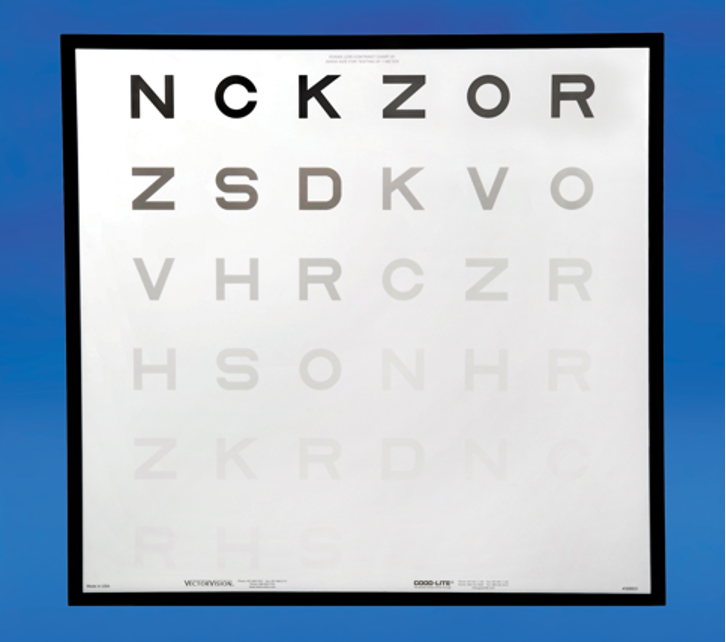ELCT Vs Pelli Robson
Overview
The Evans Letter Contrast Test (ELCT) and the Pelli-Robson (PR) chart are established methods for assessing letter contrast sensitivity. Both use the same validated scientific format:
- Large letters arranged in triplets
- Each triplet presented at a different contrast level
- Contrast decreases by 0.15 log units per triplet
- 16 contrast levels overall
- Patients must identify at least 2 letters per triplet to proceed to lower contrast level
- Each letter contributes 0.05 log contrast units to the final score
This format enables consistent measurement of letter contrast sensitivity.
Evans Letter Contrast Test

Key Differences Between ELCT and Pelli-Robson
Letter Size and ETDRS Compatibility
Pelli-Robson:
- Uses a non-standard letter size subtending ~2.8° visual angle at 1 meter (~20/674 acuity).
- Does not correspond to ETDRS letter sizing.
ELCT:
- Employs a standardized 1.5 logMAR letter size (20/630), aligning with ETDRS scales.
- Enables direct correlation with ETDRS acuity scores.
Luminance and Illumination
Pelli-Robson:
- Relies on external room lighting.
- Luminance variation can exceed 25–30% across chart.
- Susceptible to reflections and glare, reducing letter contrast and skewing results.
“To avoid skewed results and ensure reliability, it’s essential to prevent glare and mirror-like reflections.” (Thakur S. et al., Eye, 2018)
ELCT:
- Engineered for backlit illumination
- Using calibrated LED backlit source, provides uniform luminance (<5% variation) across all contrast levels.
- Eliminates reflections and the need for any ambient light interference.
Backlit Chart Design and Validation
Pelli-Robson:
Originally developed as a printed chart. The retro-illuminated version has no published validation comparing results.
Chart Vs Retro-Illuminated Pelli Robson: The manufacturers of the PR chart have sought to overcome the inadequate lighting standardization of their test and have developed a retro-illuminated version. Unfortunately, due to the calculation of letter contrast via the Weber Standard used for letter contrast sensitivity tests (see below), printed charts and retro-illuminated charts have to use different contrast levels to obtain matching results.

The darker surfaces (ie the letters) on a printed chart provide a different level of measured luminance, MinL, than when the same letters are retro-illuminated. This variance increases as the contrast of the letters decrease. As such, there are no validating studies to show that the PR chart and the PR retro-illuminated version provide identical results, or even similar results.
ELCT:
- Developed exclusively as a backlit letter contrast test.
- Validated under uniform illumination. All measurements and calculated Weber Contrast values developed with chart uniformly back lit.
Summary – ELCT Testing Advantages
- ETDRS-standard letter sizing
- Uniform calibrated illumination
- Reduced reflections and glare
- Validated contrast levels
- Faster setup, no external lighting adjustments
Due to these advantages, ELCT shows lower test variance than Pelli Robson Chart (Amirkhanian A. et al., IOVS, 2018).
Comparison Table
| Attribute | ELCT | Pelli-Robson |
|---|---|---|
| Letter Size | ETDRS-standard 1.5 logMAR (20/630) | Non-standard (~20/674) |
| Luminance | Uniform backlit illumination | External lighting required |
| Reflections | None | Prone to reflections which skew results |
| Validation | Validated under backlit conditions and data comparing to PR Chart | No comparative validation of PR chart versus PR backlit |
| Setup | Quick insert into ETDRS cabinet | Room lighting and room set up required |
| Contrast Data | Published | No published data for retro-illuminated version |
| Configuration | Two charts, fit in standard cabinets | One long chart or 2-piece chart for backlit version |
| Cost | Comparable | Comparable |

